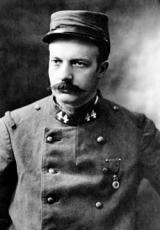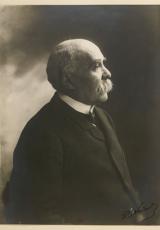La naissance des associations d'anciens combattants

Corps 1
The birth of ex-servicemen associations The First World War had a profound effect on the men involved, on both their bodies and their minds. The first associations came into existence in 1916 in response to the serious problems of those wounded servicemen, crammed into hospitals whilst waiting to return to civilian life. At the same time, disabled soldiers on leave or who had been discharged and were facing great practical or mental problems also created associations to offer advice and help. After 1918, returning to civilian life was difficult. The social climate was strained and so servicemen's associations were set up, as an expression of protest by citizens demanding justice.
Corps 2
Ex-servicemen associations exist in all countries. The French associations are unique in character. They are powerful - three million members in the 1930's - very diverse - there were several thousand of them, although the two largest at the time, the Federal Union of Disabled Servicemen (l'Union fédérale des mutilés or UF) and the National Union of Servicemen (l'Union nationale des combattants or UNC), accounted for more than half of the members - and democratic in their structure and management. Above all, they had a special relationship with the Republican State, in which citizens were able to organise themselves in order to have their rights acknowledged and take any resulting action into their own hands. They were not just veterans being helped by charitable organisations but citizens proud of what they were, voters demanding justice. We can distinguish two successive waves of ex-servicemen's associations. The first were formed during the 1914-1918 war itself: they were associations of disabled and discharged soldiers. The discharge procedure was one by which the army decided that a wounded or sick soldier was no longer able to serve, whether temporarily or permanently. The discharge was pronounced by a committee of military doctors.
This procedure worked very badly and created deep discontentment amongst the wounded. First of all, they often had to wait a long time, in a military hospital or depot, before passing in front of the discharge committee. These committees were overloaded, as there were large numbers of wounded and only a small number of doctors available. In addition, before presenting the wounded to the committee, the army would wait until their condition had stabilised, in the hope of possibly avoiding a discharge. And so there came to be thousands of inactive soldiers awaiting discharge, who set up groups where discontentment festered.
Disabled soldiers mobilise for moral recognition
On returning to civilian life, discharged soldiers confronted countless problems. Many did not know how to live. The State, in fact, only gave them pathetic benefits. The pensions law in force during the war dated from 1831. It had been conceived for a professional army, and not at all for a conscripted army and for a war that would mobilise eight million men.
Those who were unable to return to their jobs, for example farmers who had had a leg amputated, risked becoming a burden on their family. Some were even reduced to begging. Apart from all these financial problems, they had legitimate demands to put forward to their mayors and prefects: for example for the right to be able to sit down on trams or the underground. To a lesser or greater extent, such problems were made more acute by their situation. Hearing praise every day for heroes on the one hand, whilst having lost an arm or a leg and ending up unemployed or begging was absolutely unbearable. The contrast between the official line on the one hand and the reality of the suffering and daily life on the other was too acute. On the other hand, during wartime any man not on the frontline and whose injuries were not visible could easily be mistaken for a shirker. One of the first demands made by discharged soldiers in 1917 was to have a badge to avoid such hurtful embarrassment. The wish for moral recognition was shared unanimously. Even more than the practical demands, this was what drove disabled servicemen to form groups in order to exist as a body in the public sphere. The birth of local disabled associations - the term used in fact for all discharged servicemen - was relatively early: in February 1916 in Saint-Etienne, in March in Aix en Provence with René Cassin and in April in Nancy.
They rallied round to help their comrades in difficulty and got themselves received by mayors and prefects. Some established themselves in rehabilitation centres or hospitals, like the General Association of disabled war veterans (l'Association générale des mutilés de guerre) at the Invalides, where the institution's director general was taken as its president. The creation of the Journal des Mutilés (The Disabled Servicemen's newspaper) in May 1916 provided them with a platform, although for its founders it was also a business. The newspaper's readership quickly increased and on the 11th November 1917 it was in a position to convene an assembly at the Grand Palais in Paris of all the associations, who forcefully demanded that the right to compensation should be at the centre of the pensions bill currently under discussion. The way the promoters saw it, this first assembly was to lead to the creation of a national union, but a large number of local associations, fearing they were being manipulated by the Parisians, called for a second assembly in Lyon, from the 24th to the 26th February 1918. The Union fédérale came out of this. When the war ended, the disabled servicemen's associations were therefore already in place. They then became involved in the latest discussions on the pensions bill of the 31st March 1919 and in setting up the departmental committees of the National Office of disabled servicemen, as provided for by the bill of the 2nd January 1918, in order to organise their rehabilitation and employment. As there were many more ex-servicemen than disabled veterans, accommodating them ran the risk of them becoming overwhelmed by other demands and losing their identity. Some would opt to open up, like those in Le Havre, Lyon and Grenoble, which in so doing would see a rapid expansion. Others, having made the same choice, were unable to withstand the pressure between the different interests and would split into two distinct associations, without necessarily being in conflict with each other. And others would not accept ex-servicemen and would see servicemen's associations set up alongside them.
Discontentment brews amongst the demobbed
The political context played a major role here. The end of the war saw, in France as well as in Germany, Italy and Great Britain, the explosion of a social crisis that had already been smouldering and was aggravated by the redevelopment of the wartime factories.
The Russian Revolution had given rise to a great sense of hope. Strikes broke out on all sides, sometimes taking on a revolutionary aspect, such as those of the Parisian metalworkers in June 1919. Clemenceau set up a protection plan for public buildings. He had his men patrol Paris on the 1st May 1919, where fighting left one dead and many injured. There was a risk that the ex-servicemen would swell the ranks of Reds, as discontentment brewed amongst the demobbed soldiers. The government climbed down: it made servicemen and widows exempt from taxes due during the war years, if their income was below 5,000 F. It introduced a demobilisation bonus of 250 F, increased by 20 F for each month spent at the front. But the most effective response was in coordinating the demobbed men before the Left was able to, from which came the creation of the UNC. In contrast to the UF, which came from below and slowly at that, the UNC came from above and quickly. It was the idea of a military chaplain, Father Brottier - after the war, he ran the Auteuil Orphans Foundation along with volunteers and Catholic charities. The UNC benefited from support from conservative circles. Clemenceau had encouraged Father Brottier and had given him a grant of 100,000 F. The army had allowed the UNC, whose president was a General, to put its promotional literature in its homes for soldiers.
Several bishops advised their clergy to encourage the creation of branches of the UNC. Some banks helped with this: one of its first advertising promotions was to offer subscribers their demobilisation bonus in cash, in exchange for the treasury bonds that they had received. A bank was necessary to support the operation. Conversely, the UNC helped the PLM (1) to overcome the railway workers' strike of 1920, receiving 100,000 F from them for this. The support of the government, the army, the church and the business community allowed the UNC to mobilise existing networks and thus expand rapidly, especially in the West. Registered on the 11th November 1918, it already had a presence in 72 départements and 100,000 members at its first general assembly in February 1919. In 1921, with 317,000 subscribers, it was ahead of the UF who had 255,000 voters at its congress (2). Afterwards, the UNC would become strong enough to do without the initial backing and the UF would grow stronger, to the point where it would overtake. Though they did not disappear, the political divides faded into a less confrontational situation. The expansion of rival associations to the right of the UNC and to the left of the UF gave them a more unified sense of direction. For all that, local autonomy remained strong and parish matters often took precedence over any national affiliations.
Alongside these two large associations, others formed from the war onwards. Associations for the generally disabled, such as the General Association for disabled war veterans, the National Union for Disabled and Discharged Veterans and the National Federation, of which Maginot became president at the end of 1918. Specialist associations, such as for the blind, those with lung injuries, amputees, those with facial injuries and others of a more cooperative nature, for postal workers or teachers, for example, not forgetting politicised associations, such as Barbusse's ARAC and the Workers' and Farmers' Federation.
Did this great number of associations weaken the servicemen's movement? International comparisons rather suggest the opposite, if we take into account all members. And as for its effectiveness, it did not suffer, since all social action was conducted in conjunction with the State by the national offices (for the disabled, orphans and then ex-servicemen) and departmental committees and offices where the associations were fairly represented. This combination of democratic diversity and cooperative management is what made the servicemen's movement in France unique.
Notes : (1) Paris-Lyon-Mediterranean Railway Company (1857-1938). (2) For details and further information on this subject, see Antoine Prost, Les anciens combattants et la société française, 1914-1939, Presse de la FNSP, 1977, tome I / Histoire.



